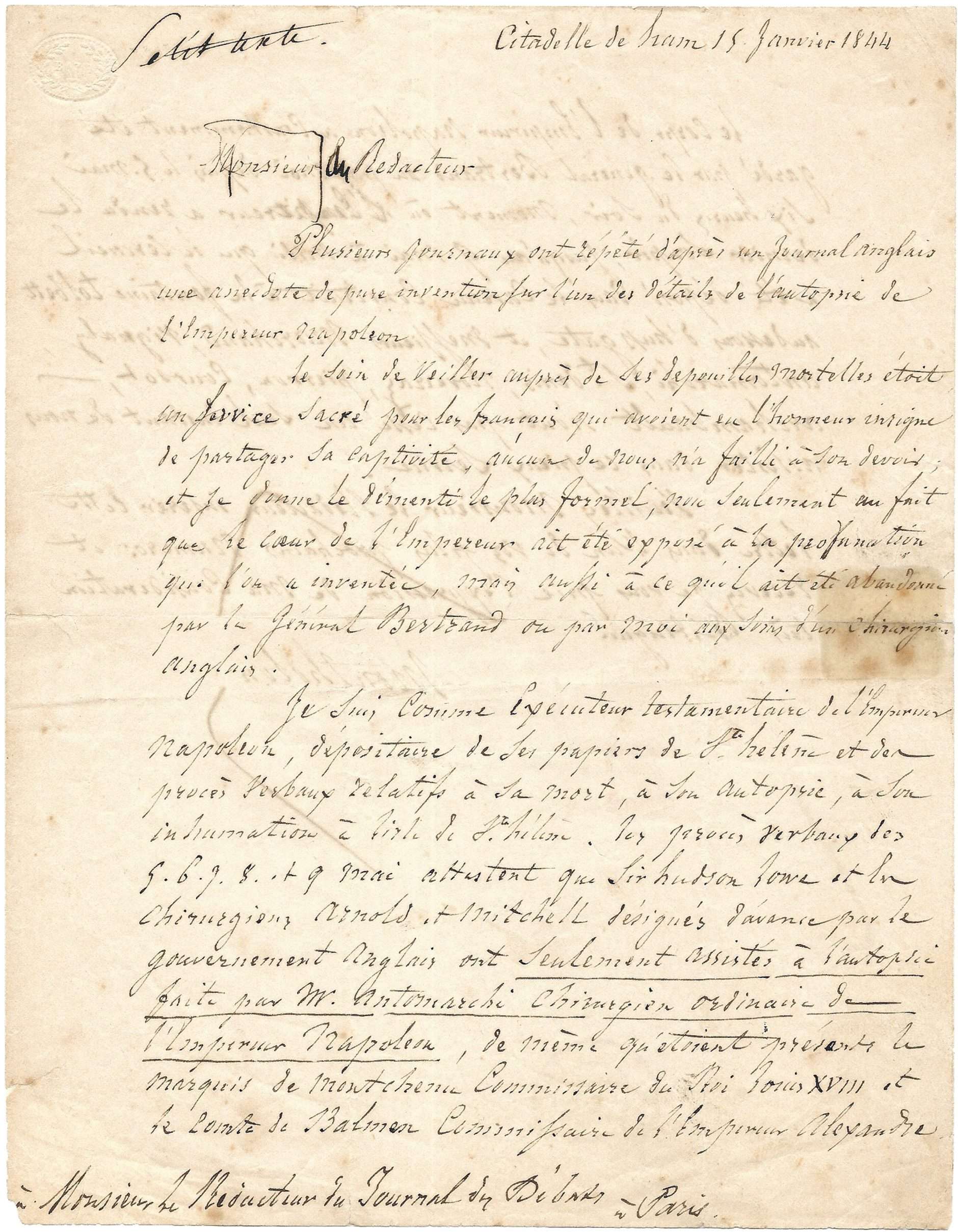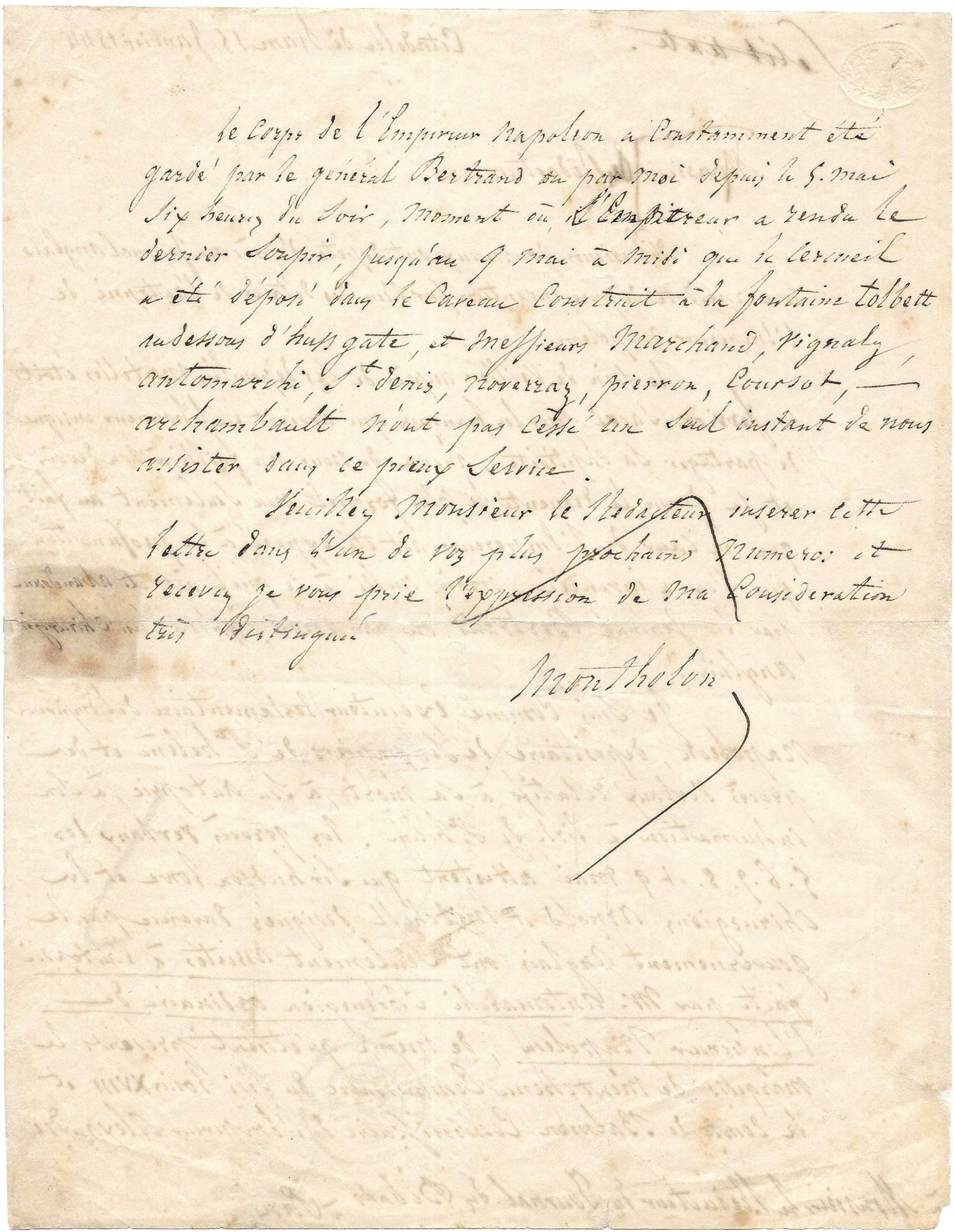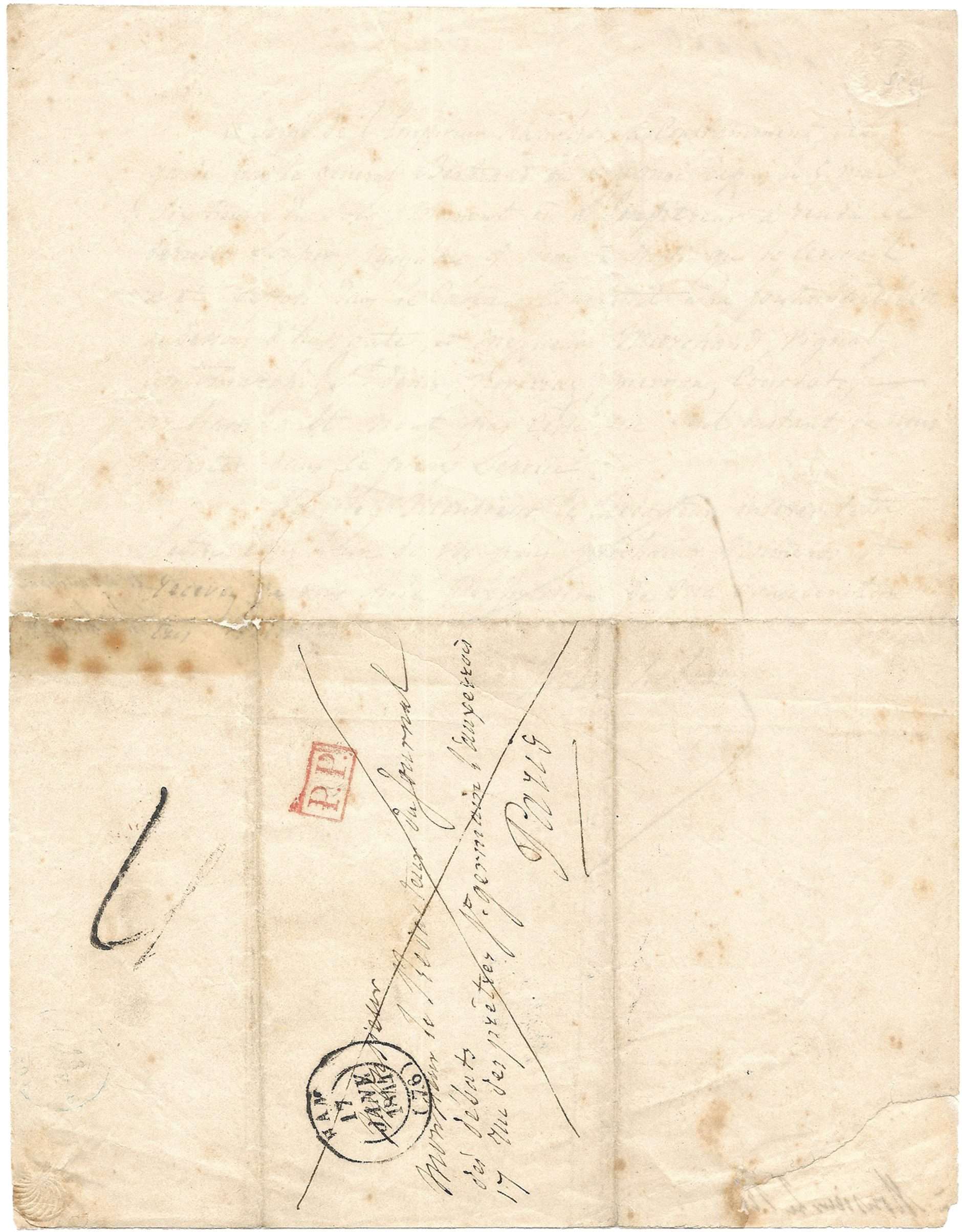[NAPOLÉON] MONTHOLON (de), Charles-Tristan (1783-1853)
Autograph letter signed « Montholon » to the Journal des débats
Ham, 15 January 1844, 1 p. 1/2 in-4°
« The body of the Emperor Napoleon has been constantly guarded by General Bertrand or by me since six o’clock in the evening of May 5, when the Emperor passed away »
Fact sheet
[NAPOLÉON] MONTHOLON (de), Charles-Tristan (1783-1853)
Autograph letter signed « Montholon » to the editor-in-chief of the Journal des débats [Armand Bertin ?]
Ham prison, 15 January 1844, 1 p. 1/2 large in-4° (19,4 x 24,9 cm)
Restored adhesive tape residue with slight discoloration to the right margins, small browning, broken wax seal on the second page
Autograph address on fourth page “Ham / 17 janv. 1841”
Typographical notes
Extraordinary letter from Montholon reestablishing the truth about the autopsy and burial of Emperor Napoleon on the island of Saint Helena
« Monsieur le Rédacteur,
Plusieurs journaux ont répété d’après un journal anglais une anecdote de pure invention sur l’un des détails de l’autopsie de l’Empereur Napoléon.
Le soir de veiller auprès de ses dépouilles mortelles étoit un service sacré pour les français qui avaient eu l’honneur insigne de partager sa captivité, aucun de nous n’a failli à son devoir ; et je donne le démenti le plus formel, non seulement au fait que le cœur de l’Empereur ait été exposé à la profanation que l’on a inventée, mais aussi à ce qu’il ait été abandonné par le Général Bertrand ou par moi aux soins d’un chirurgien anglais.
Je suis comme exécuteur testamentaire de l’Empereur Napoléon, dépositaire de ses papiers de Ste Hélène et des procès-verbaux relatifs à sa mort, à son autopsie, à son inhumation, à l’Ile de Ste Hélène. Les procès-verbaux des 5.6.7.8. et 9 mai attestent que Sir Hudson Lowe et les chirurgiens Arnold [sic] et Mitchell désignés d’avance par le gouvernement Anglais ont seulement assistés à l’autopsie faite par M. Antommarchi , chirurgien ordinaire de l’Empereur Napoléon, de même qu’étoient présents le marquis de Montchenu Commissaire du Roi Louis XVIII et le comte de Balmen [sic] Commissaire de l’Empereur Alexandre.
Le corps de l’Empereur Napoléon a constamment été gardé par le général Bertrand ou par moi depuis le 5 mai six heures du soir, moment où l’Empereur a rendu le dernier soupir, jusqu’au 9 mai à midi qu[and] le cercueil a été déposé dans le caveau construit à la fontaine Tolbett au-dessous d’Hussgate, et Messieurs Marchand, Vignaly, Antommarchi, St Denis, Noverraz, Pierron, Coursot, Archambault n’ont pas cessé un seul instant de nous assister dans ce pieux service.
Veuillez Monsieur le Rédacteur insérer cette lettre dans l’un de vos plus prochains numéros et recevez je vous prie l’expression de ma considération très distinguée.
Montholon »
The Emperor’s death began on May 17, 1821, when he described to his entourage a stomach pain like a “pencil stab.” From then on, Napoleon was bedridden. Having settled at Longwood since September 1819, François Antommarchi (1789-1838) was appointed—at the insistence of the Bonaparte family—the Emperor’s new physician. Antommarchi remained powerless in the face of the situation. Bertrand and Montholon finally overcame the patient’s reluctance and called for help from another physician, this time British, Dr. Arnott. This still changed nothing. Napoleon died on May 5, 1821, at 5:49 p.m. Montholon was the one who turned a blind eye to the Emperor. The Governor of the Island, Sir Hudson Lowe, comes with his staff and the French Commissioner, the Marquis de Montchenu, to officially note the death of “General Bonaparte”.
In his will, Napoleon wrote: “I bequeath to the Count of Montholon two million francs as proof of my satisfaction with the filial care he has given me for six years. I bequeath to Bertrand five hundred thousand francs. I bequeath to Marchand, my first valet, four hundred thousand francs. The services he has rendered me are those of a friend. I wish him to marry a widow, sister or daughter of an officer or soldier of my Old Guard. I appoint the Counts Montholon, Bertrand and Marchand as my executors […].”
The body was opened on May 6, 1821 at 2:00 p.m. by Antommarchi, assisted by five English doctors: Doctors Thomas Shortt, Archibald Arnott, Charles Mitchell, Francis Burton and Matthew Livingstone noted in their autopsy reports the existence of a perforated chronic gastric ulcer (which would have caused fatal peritonitis), probably developing into cancer, and lung lesions linked to tuberculosis. Before closing the corpse, the heart and stomach were removed and placed in silver cups containing spirits of wine.
Montholon is not seen embarking on the Belle Poule on July 7, 1840, to join the expedition to return the ashes. However, he was present a month later at the disastrous landing at Boulogne-sur-Mer on August 6. This adventure earned him a sentence of six years in a fortress in Ham (department of the Somme) by a ruling of the Court of Peers on October 6, 1840. His friend Gourgaud freed him on July 10, 1846, after the escape of Louis-Napoléon Bonaparte, the future Napoleon III.
Provenance:
Private collection
Bibliography:
We have not found any trace of the publication of this letter in the Journal des débats. It was nevertheless transcribed in full in Le Patriote Français [2e année], 12 mai 1844, p.2.
Source:
Revue du Souvenir Napoléonien, Albert Benhamou, avril-juin 2011, p. 10-17





